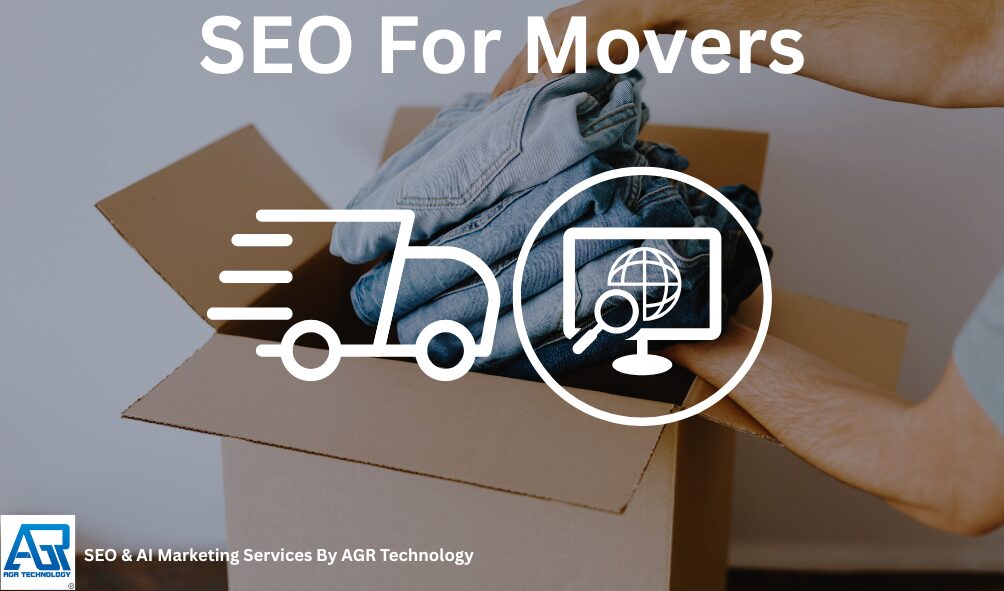If you run a moving company, you don’t just want traffic, you want booked jobs. We get it. At AGR Technology, we build SEO services for movers that turn local searches into quote requests, calls, and calendar bookings. Below is our practical approach for November 2025, what matters now, what to skip, and how we’ll carry out it for your service area. Clear steps, real-world tactics, and zero fluff.
Need help growing your organic search presence? Contact AGR Technology to see how we can help
How People Search For Movers Today

Most moving leads start with urgent, local intent. People want someone nearby who can do the job soon, at a fair price, with good reviews. That shapes how we structure your SEO strategy.
What we see in search data and call logs:
- “near me” and suburb/city + service: movers near me, local moving company [suburb], office movers [city]
- Job type and distance: long-distance movers, interstate movers, apartment movers, piano movers
- Price and timing: moving quotes, cheap movers, same-day movers, weekend movers
- Info-led searches before booking: moving checklist, moving costs, packing tips, truck sizes
- Heavy mobile and map usage: most calls come from mobile SERP features like the local pack and call buttons
How we turn this into booked jobs:
- Map intent to pages: service pages for each job type, and location pages for key suburbs/metros
- Build trust fast: ratings, licenses/insurance, real photos, and social proof above the fold
- Remove friction: sticky call button, short quote form, clear service areas, instant response automations
On-Page SEO Essentials For Moving Websites
On-page is where rankings meet conversions. We make your site easy for Google to understand and easy for customers to choose you.
Core pages we build or refine:
- Service pages: local moving, interstate/long-distance, office/commercial, packing and unpacking, storage
- Location pages: high-value suburbs/cities you actually serve (no thin, copy-paste pages)
- Proof pages: reviews/testimonials, case studies, licensing/insurance, FAQs, before/after galleries
What we optimise on every page:
- Titles and H1s: clear keywords + value (“Local Movers in [Suburb] – Fast Quotes & Licensed Crew”)
- Internal links: guide users (and Google) from top pages to relevant services and locations
- Conversion UX: short quote form, phone and SMS options, live chat, clear pricing signals, trust badges
- Schema markup: LocalBusiness, Service, FAQ, and Review schema for richer results
- Content depth: specific services, truck sizes, access constraints (stairs, lifts), packing materials, insurance
Practical extras that lift conversions:
- Real crew photos and branded trucks (not stock)
- Service footprint map and response time windows
- “What to expect on moving day” checklist
- Clear cancellation and reschedule policy
Get an on-page audit and action plan. We’ll point out quick wins you can carry out this month.
Local SEO: Google Business Profile, Citations, And Reviews

Your Google Business Profile (GBP) is often the first impression. Winning the local pack means more calls, fast.
Google Business Profile setup and optimisation:
- Primary category: Moving company (plus relevant secondary categories)
- Service areas: priority suburbs/metros you can reach fast
- Services list: local, interstate/long-distance, office, packing, storage
- Photos and videos: crews, trucks, warehouse, before/after, short clips from jobs
- Posts and Q&A: weekly updates, seasonal offers, and answers to common questions
- Messaging and call tracking: turn chats into quotes and measure every lead
Citations and NAP consistency:
- Standard platforms: Yelp, Yellow Pages, Facebook, Apple Maps, Bing Places, BBB/industry sites
- Local/industry sites: chambers of commerce, real estate directories, comparison marketplaces
- One rule: identical Name, Address, Phone (NAP) everywhere: track changes to avoid duplicates
Reviews that drive rankings and trust:
- Ask every customer: automated SMS/email request with direct Google link
- Make it easy: QR codes on invoices and truck signage
- Respond to all reviews: quick, helpful replies (Google recommends it)
- Policy-safe: no review gating: follow Google’s review guidelines
AGR Technology program:
- We set up a reviews engine, integrate with your CRM/job system, and monitor sentiment. Expect steady growth in high-quality, keyword-rich reviews.
Content And Link Building That Actually Work For Movers
Content should match real questions and routes your customers care about. Links should come from genuine local relationships. No fluff.
Content we create that converts:
- Cost and scope pages: what affects price, minimums, travel time, packing rates
- Service-area hubs: suburb/city pages with landmarks, access issues, and parking rules
- Route pages: popular city-to-city moves (e.g., Brisbane → Sydney, Houston → Austin)
- Checklists and guides: moving timeline, packing lists, strata/apartment moving rules
- Commercial/office move resources: IT moves, lift bookings, after-hours policies
- FAQs: insurance, fragile items (pianos, antiques), stairs/lift fees, cancellations
Link building that’s safe and effective:
- Local sponsorships: sports clubs, school events, charities (with website links)
- Partnerships: storage facilities, real estate/property managers, cleaning companies
- Business associations: chambers of commerce and industry councils
- Digital PR: data-driven stories (seasonal moving trends, top suburbs people move to)
- Testimonials for suppliers: earn a link on their “clients” or “reviews” page
Technical SEO, Site Speed, And Conversion Tracking
Speed, stability, and measurement tie the whole strategy together. If your site loads slowly or tracking is off, you’ll leak leads.
Technical and speed priorities:
- Core Web Vitals: pass LCP, INP, CLS on mobile
- Fast media: compress images, next‑gen formats, lazy-load galleries
- Clean build: lightweight theme, minimal scripts, server caching/CDN, HTTP/2 or HTTP/3
- Crawl health: XML sitemap, robots.txt, no broken links, correct canonicals and redirects
- Security: HTTPS, regular updates and backups
- Accessibility basics: readable fonts, contrast, keyboard navigation
Conversion tracking we carry out:
- GA4 + Google Tag Manager: events for calls, form submits, quote tool interactions, chat starts
- Call tracking with dynamic number insertion: attribute calls by channel and page
- UTM standards: separate organic SEO from PPC and social
- CRM integration: push leads to your system and track to “booked job” and revenue
- Dashboard reporting: rankings, local pack visibility, calls, forms, cost per booked job
Why it matters:
- You’ll see which pages and suburbs deliver the best leads
- We can scale what works and cut wasted spend
Conclusion
SEO for movers is straightforward: match search intent, win the local pack, publish useful content, earn local links, keep the site fast, and measure to booked jobs, not just clicks.
At AGR Technology, we build and manage the entire system for moving companies, from on-page and GBP to content, links, and tracking. If you want more calls and a fuller calendar, we’re ready to help.
SEO for Movers: Frequently Asked Questions
What is SEO for movers and how does it drive more booked jobs?
SEO for movers aligns your website and Google Business Profile with urgent, local searches (e.g., “movers near me,” “apartment movers [city]”). You build focused service and location pages, add trust signals, and remove friction with click-to-call and short quote forms. The result: more local pack visibility, more calls, and booked jobs.
Which pages should a moving company build for local SEO?
For SEO for movers, prioritize service pages (local, long-distance, office/commercial, packing, storage), unique location pages for high-value suburbs/cities, and proof pages (reviews, licensing/insurance, case studies, FAQs, galleries). Optimize titles/H1s, internal links, conversion UX, schema (LocalBusiness, Service, FAQ, Review), and content depth like truck sizes, access constraints, and insurance details.
How can movers rank higher in the Google local pack?
Fully optimize your Google Business Profile: correct primary/secondary categories, defined service areas, complete services list, fresh photos/videos, weekly Posts and Q&A, and messaging. Build consistent citations with identical NAP, earn steady Google reviews, and reply to all feedback. These signals, plus proximity and relevance, drive more local pack calls.
How long does SEO for movers take to show results?
Most movers see early gains in 4–8 weeks once on-page fixes and GBP optimization go live, especially in less competitive suburbs. In busy metros, meaningful ranking and lead growth often take 3–6 months, with compounding results by 6–12 months. Track booked jobs, not just rankings, to judge progress.
Is SEO or PPC better for moving companies?
Neither is universally better. SEO for movers builds durable local pack and organic visibility that lowers cost per lead over time. PPC delivers instant exposure for high-intent terms and can fill gaps or seasonality. The best approach pairs both, with shared tracking and messaging, then reallocates budget to the highest ROI channels.
How should a moving company track SEO leads and ROI?
Set up GA4 and Google Tag Manager to track calls, form submits, live chat, and quote tool events. Use dynamic number insertion for call attribution, consistent UTM naming, and connect your CRM to push leads through to booked job and revenue. Build dashboards showing rankings, local pack visibility, and cost per booking.
Related content:
Digital Marketing For Tradesmen
SEO Services For HVAC Companies
SEO Services for Large Language Models (LLMs)
SEO Services For Roofing Companies

Alessio Rigoli is the founder of AGR Technology and got his start working in the IT space originally in Education and then in the private sector helping businesses in various industries. Alessio maintains the blog and is interested in a number of different topics emerging and current such as Digital marketing, Software development, Cryptocurrency/Blockchain, Cyber security, Linux and more.
Alessio Rigoli, AGR Technology
![logo-new-23[1] logo-new-23[1]](https://cdn-ihdfn.nitrocdn.com/eZVJvoSTyVixkEUySRKiaseNtUlmgCyu/assets/images/optimized/rev-d69570f/agrtech.com.au/wp-content/uploads/elementor/thumbs/logo-new-231-qad2sqbr9f0wlvza81xod18hkirbk9apc0elfhpco4.png)
